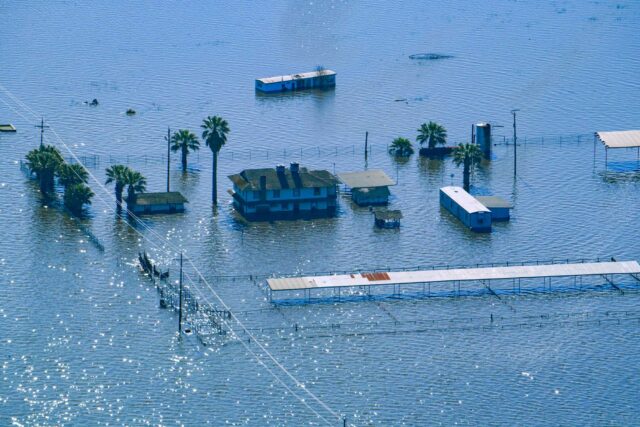Lois Henry is the engine behind the small but mighty two-person journalistic operation that is SJV Water, an independent, nonprofit news site dedicated to covering water in the San Joaquin Valley. She and reporting partner Jesse Vad have been at ground zero for much of the spring flooding that’s already occurred. We asked her what she’s seen—and what might happen as the weather heats up.

The San Joaquin Valley has already experienced serious flooding this year. What are you seeing on the ground?
First, I know that some people are cheering on the return of Tulare Lake. The water is coming back to the former lake bed, but I want to be clear that it’s not pretty. This is a very sterile, segmented environment, and the water is turbid, it’s ugly, it’s full of god-knows-what—and it’s causing huge damage.
This floodwater has destroyed family homes, livelihoods, farms, and dairies. The flooding of homes in March was devastating. Most people don’t have flood insurance, because it’s wildly expensive; they’re not going to come back from this. And massive amounts of cropped acreage will be destroyed, too. This will affect the livelihoods of growers and their employees, and growers’ ability to borrow money for a long time.
Furthermore, the water is still out there, and it’s not going to go away. Roads are closed, and if the railroad tracks remain flooded, they’ll have to be closed. They are the spine for interstate commerce up and down this valley; a closure will create serious supply chain problems.
Folks in the valley are notorious for wanting government to stay out of their lives, yet this is precisely the time when government can be helpful. How is that going?
Well, trying to figure out the chain of responsibility for the main river channels—let alone ephemeral creeks like Poso Creek, White River, Lewis Creek, and Deer Creek—is a challenge. When waters rise, there’s a mad scramble to figure out who’s in charge and what to do.
There were so many breaks on the Tule River because it was carrying an immense amount of water and may have been slowed from draining into Tulare Lake. Who was in charge of managing those banks prior to a flood? Where did money come from? Who was in charge of making sure that appropriate maintenance was being done? This is all a hodgepodge.
Even if the San Joaquin Valley powers-that-be don’t want state oversight, each county does need a clear set of local cooperation agreements—and an agreed upon decision tree for what to do and when, because these rivers don’t care about county boundaries. We don’t have a chain of control, or if we do, it’s been long forgotten, at least since the 1983 flood.
Can you speak about some of the tensions you’ve faced in covering these issues? And what bright spots have you seen?
The bright spot is that a lot of people are paying attention to water in this section of the valley. I’ve been a reporter for 30 years. People cover the Delta, they cover the Colorado River—and that’s what they consider to be California water—but there’s this whole midsection where things are happening. That’s why I started SJV Water in late 2018: to draw attention to these issues and how they play into larger state issues. I’ve been out here in the wilderness, but now people are seeing that they should pay attention.
Water managers may not see all the attention as a bright spot because they think it makes their jobs more difficult when they have to do it under a microscope. But water is a public resource and these are public agencies.
There have been incidents where the police have been issuing warnings to people who are doing their jobs. I’ve reported on these: in one case, a warning was issued to someone managing the levees, and in another to me, as I tried to report on the flood situation. It’s all part of the broader problem, in which there are no clear lines of responsibility for managing a flood fight and keeping people out of harm’s way.
Anything else we should know?
Now that disasters have been declared, there is a required after-action review. I’m really hoping that this review helps us prepare for what’s next. Everybody wants to call this event “unprecedented,” but it’s not. These kinds of floods happen every decade or so. Some are worse than others, but we should learn from this: how to protect communities and how to provide information so that community members know who to call if they’re worried or afraid. And everybody should know who’s in charge of which piece of infrastructure, because infrastructure matters. Zero politicians want to take it on because it’s so not sexy…but infrastructure matters.





